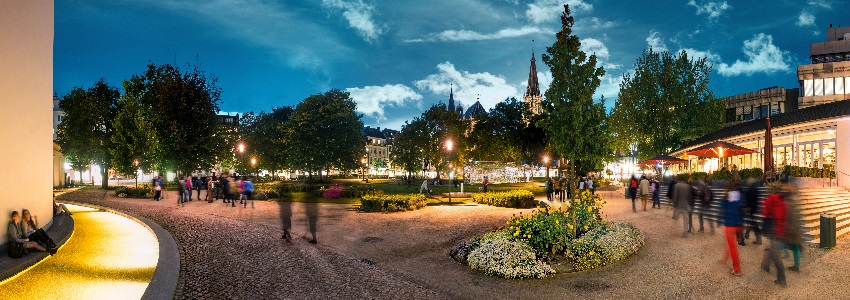Together with the Dutch towns Maastricht and Heerlen and the Belgian towns Liège and Hasselt, the German town of Aachen is one of the main population centres of the transnational Euregio Maas-Rhine.  At the point where the three countries Belgium, Germany and the Netherlands meet, on an area of nearly 11,000 km² and with a population of 3.7 million, it consists of five partner regions - the Regio Aachen, a part of the Dutch province of Limburg, the two Belgian provinces of Limburg and Liège and the German-speaking community of Belgium.
At the point where the three countries Belgium, Germany and the Netherlands meet, on an area of nearly 11,000 km² and with a population of 3.7 million, it consists of five partner regions - the Regio Aachen, a part of the Dutch province of Limburg, the two Belgian provinces of Limburg and Liège and the German-speaking community of Belgium.
At the interface of the major commercial and industrial centres of north-western Europe (Paris, Luxembourg, Brussels, the German Ruhr area, Holland’s Randstad and the Flemish cities) the Euregio Maas-Rhine has an extremely fortunate geographic situation. The big seaports of Antwerp and Rotterdam are not far away, and the regional airports of Liège and Maastricht-Aachen and the international airports of Düsseldorf, Cologne, Amsterdam and Brussels are in the immediate or near vicinity. The Euregio Maas-Rhine is also connected to the European inland waterway network for goods transport via the Albert Canal and the Juliana Canal / Maas. Connections to the rail network are excellent, in both a north-south and an east-west direction. The European high-speed train TGV stops at Liège and Aachen.
This exceptional position offers a great advantage to businesses. A study has shown that two-thirds of the industrial estates in the Euregio Maas-Rhine are easily or very easily reached. In the last few years a total area of over 16,000 hectares has been made available for commercial purposes. In addition, the Euregio Maas-Rhine has two research parks, two industrial and innovation parks and 26 enterprise centres with emphasis on top technology and the development of the service sector.
The Euregio Maas-Rhine has much to offer in the field of education and research, too. Nearly 100,000 students attend the five universities (Rheinish-Westfälische Technische Hochschule Aachen [Technical University], Université de Liège, Universität Maastricht, Limburgs Universitair Centrum Diepenbeek, Open Universiteit Heerlen) and the numerous Universities of Applied Sciences, research centres and university teaching hospitals which work hand in hand and complement each other.
The Euregio Maas-Rhine came into being in 1974. During an official visit to the town of Maastricht the future queen of the Netherlands, Princess Beatrix, suggested giving special support to the transnational cooperation between the regions that had flourished in the past. As a result, the governors of the Belgian provinces Limburg and Liège, the Queen’s Commissioner of the Dutch province of Limburg and the Chief Officer of the city administration of Cologne decided to set up a study group with the aim of intensifying this cooperation. Two years later a fundamental agreement was concluded on the subject. In 1992 the German-speaking community of Belgium joined the study group as the fifth partner region and a part of the province of Liège enjoying equal rank. Since 1991 the Euregio Maas-Rhine has had a legal basis in the form of a "Stichting" based on Dutch law. This "Stichting" with its seat in Maastricht coordinates the transnational cooperation of the five partner regions.
The Euregio Maas-Rhine is currently active in eleven different fields: economic cooperation; cultural events; language projects; travel packages; sporting events; disaster services; youth work; educational policy; technology transfer; health services, and environmental projects. This "euregional" cooperation brings its greatest benefit to the people who live in the Euregio Maas-Rhine, for the transnational cooperation between the five partner regions enables them to emphasize their claim to equal living conditions in the new Europe of Regions. The focus is on the citizens’ active participation in such transnational work - based on the common conviction that the dialogue between neighbouring regions which are separated only by national borders and face the same problems can and will contribute to European cooperation and integration.
Euregio Maas-Rhine www.euregio-mr.org
Nearby regions:
Province of Limburg (B) www.limburg.be
German-speaking Community of Belgium www.dglive.be
Province of Liège www.prov-liege.be
Province of Limburg (NL) www.limburg.nl
Regio Aachen www.regioaachen.de
Wallonie www.wallonie.be




